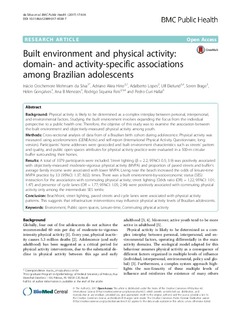| dc.contributor.author | da Sliva, Inacio C. M. | |
| dc.contributor.author | Hino, Adriano Akira | |
| dc.contributor.author | Lopes, Adalberto | |
| dc.contributor.author | Ekelund, Ulf | |
| dc.contributor.author | Brage, Søren | |
| dc.contributor.author | Goncalves, Helen | |
| dc.contributor.author | Menezes, Ana | |
| dc.contributor.author | Reis, Rodriogo S. | |
| dc.contributor.author | Hallal, Pedro C. | |
| dc.date.accessioned | 2018-01-31T09:16:35Z | |
| dc.date.available | 2018-01-31T09:16:35Z | |
| dc.date.issued | 2017-07-03 | |
| dc.identifier.citation | BMC Public Health. 2017, 17, 616 | nb_NO |
| dc.identifier.uri | http://hdl.handle.net/11250/2480862 | |
| dc.description | Open Access This article is distributed under the terms of the Creative Commons Attribution 4.0 International License (http://creativecommons.org/licenses/by/4.0/), which permits unrestricted use, distribution, and reproduction in any medium, provided you give appropriate credit to the original author(s) and the source, provide a link to the Creative Commons license, and indicate if changes were made. The Creative Commons Public Domain Dedication waiver (http://creativecommons.org/publicdomain/zero/1.0/) applies to the data made available in this article, unless otherwise stated. | nb_NO |
| dc.description.abstract | Background: Physical activity is likely to be determined as a complex interplay between personal, interpersonal, and environmental factors. Studying the built environment involves expanding the focus from the individual perspective to a public health one. Therefore, the objetive of this study was to examine the association between the built environment and objectively-measured physical activity among youth. Methods: Cross-sectional analysis of data from of a Brazilian birth cohort during adolescence. Physical activity was measured using accelerometers (GENEActiv) and self-report (International Physical Activity Questionnaire, long version). Participants’ home addresses were geocoded and built environment characteristics such as streets’ pattern and quality, and public open spaces attributes for physical activity practice were evaluated in a 500-m circular buffer surrounding their homes. Results: A total of 3379 participants were included. Street lighting (β = 2.2; 95%CI: 0.5; 3.9) was positively associated with objectively-measured moderate-vigorous physical activity (MVPA) and proportion of paved streets and buffer’s average family income were associated with lower MVPA. Living near the beach increased the odds of leisure-time MVPA practice by 3.3 (95%CI: 1.37; 8.02) times. There was a built environment-by-socioeconomic status (SES) interaction for the associations with commuting physical activity; street lighting [Odds ratio (OR) = 1.22; 95%CI: 1.01; 1.47] and presence of cycle lanes (OR = 1.77; 95%CI: 1.05; 2.96) were positively associated with commuting physical activity only among the intermediate SES tertile. Conclusion: Beachfront, street lighting, paved streets and cycle lanes were associated with physical activity patterns. This suggests that infrastructure interventions may influence physical activity levels of Brazilian adolescents. | nb_NO |
| dc.language.iso | eng | nb_NO |
| dc.publisher | BioMed Central | nb_NO |
| dc.subject | environment | nb_NO |
| dc.subject | public open spaces | nb_NO |
| dc.subject | leisure-time | nb_NO |
| dc.subject | commuting physical activity | nb_NO |
| dc.title | Built environment and physical activity: Domain- and activity-specific associations among Brazilian adolescents | nb_NO |
| dc.type | Journal article | nb_NO |
| dc.type | Peer reviewed | nb_NO |
| dc.description.version | publishedVersion | nb_NO |
| dc.rights.holder | © The Author(s). 2017 | nb_NO |
| dc.source.journal | BMC Public Health | nb_NO |
| dc.identifier.doi | 10.1186/s12889-017-4538-7 | |
| dc.description.localcode | Seksjon for idrettsmedisinske fag / Department of Sport Medicine | nb_NO |
